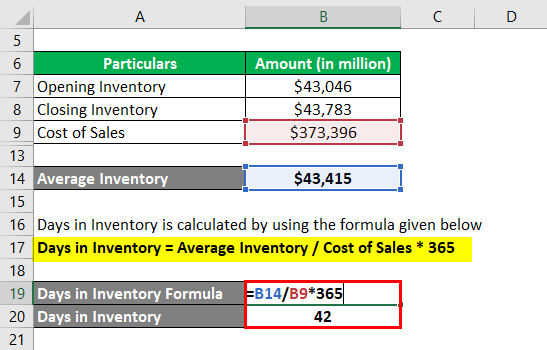

And finding the right balance is challenging. You know having too much inventory on hand ties up valuable cash flow, but having too little means losing out on potential sales. Videos More details regarding WMS features.Īs an eCommerce business owner, you likely keep a watchful eye on your inventory levels.Putaway Better and more organized putaway.B2B Wholesale Shipping Wholesale Capability with SPS Commerce.Reports Manage your performance and progress.Rate Shopping Find the cheapest rate every time.Pick & Pack Optimized picking rates up to 99.9%.Inventory Accurate inventory counts always.
#Days sales in inventory meaning plus#
Orders & Returns Native features plus third party integrations. Overview End-to-end Warehouse Management System. Section 321 Ship to Canada and save up to 20%. ParcelView Take a pic before it’s shipped. Fulfillment Centers Check out ShipHero’s Warehouse Network. Terms Similar to Days’ Sales in Inventoryĭays' sales in inventory is also known as days in inventory, days of inventory, the sales to inventory ratio, and inventory days on hand. ShortagesĮven a large DSI outcome can easily mask the presence of many inventory items that are in short supply, which are being masked by the presence of other inventory items for which there is an excessively large investment. Doing so certainly improves the sales to inventory ratio, but harms overall profitability. ProfitabilityĪ business may reduce its prices in order to more rapidly sell off inventory. Depending upon the arrangement, the company may have no inventory to report at all, which renders the DSI useless. Outsourced ProductionĪ company may switch to contract manufacturing, where a supplier produces and holds goods on behalf of the company. If the ending inventory figure varies significantly from the average inventory figure, this can result in a sharp change in the measurement. You could use the amount of ending inventory in the numerator, rather than the average inventory figure for the entire measurement period. If this calculation method varies significantly from the method the company used in the past, it can lead to a sudden alteration in the results of the measurement. Calculation ChangeĪ company may change its method for calculating the cost of goods sold, such as by capitalizing more or fewer expenses into overhead. The inventory figure used in the calculation is for the aggregate amount of inventory on hand, and so will mask small clusters of inventory that may be selling quite slowly (if at all). An indicator of these actions is when profits decline at the same time that the number of days sales in inventory declines. Large AdjustmentsĪ company could post financial results that indicate low days in inventory, but only because it has sold off a large amount of inventory at a discount, or has written off some inventory as obsolete. The days' sales in inventory figure can be misleading, for the reasons noted below. = 60.8 days' sales in inventory Problems with Days’ Sales in Inventory = ($1 million inventory ÷ $6 million cost of goods sold) x 365 days For example, if a company has average inventory of $1 million and an annual cost of goods sold of $6 million, its days' sales in inventory is calculated as: 
To calculate days' sales in inventory, divide the average inventory for the year by the cost of goods sold for the same period, and then multiply by 365. The measure can be used in concert with the days of sales outstanding and days of payables outstanding measures to determine the short-term cash flow health of a business. Instead, only use it to compare the performance of companies with their peers in the same industry. The days' sales in inventory figure can vary considerably by industry, so do not use it to compare the performance of companies located in different industries. The metric is less commonly used within a business, since employees can access detailed reports that reveal exactly which inventory items are selling better or worse than average. The days' sales in inventory figure is intended for the use of an outside financial analyst who is using ratio analysis to estimate the performance of a company. However, a large number may also mean that management has decided to maintain high inventory levels in order to achieve high order fulfillment rates. A small number of days' sales in inventory indicates that a company is more efficient at selling off its inventory, while a large number indicates that it may have invested too much in inventory, and may even have obsolete inventory on hand. Days' sales in inventory (DSI) indicates the average time required for a company to convert its inventory into sales.






 0 kommentar(er)
0 kommentar(er)
